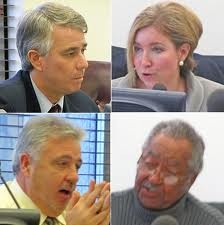
- JB
- clockwise, from top left: Mulroy, Shafer, Chism, Roland.
On Monday, December 19, the 13 members of the Shelby County Commission, mere days before Christmas, will gather for a crucial session in which there is expected to be very little give and take and an absence of seasonal good cheer as well.
With an apparent deadline of December 31, the commissioners must decide just how their 13 electoral seats should be apportioned in conformity with the Census of 2010 or see that matter referred to Chancery Court for resolution.
(We say “apparent” because former Commercial Appeal reporter Jimmie Covington, a maven in such matters, insists that, with no Commission elections scheduled before 2014, the deadline should be regarded as December 31, 2013. In fact, the Commission has already resolved that any vacancies to be filled in the meantime will observe the current district lines. The County Attorney’s office regards the end of this year as the appropriate drop-dead date, however.)
Informal polling of the Commission suggests that the present divide between those who favor large, multi-member districts and those who want single-member districts is unbridgeable.
When the Commission met on Friday in a special session, called expressly to expedite an agreement, the vote was 7-5, with the majority favoring a demographically updated version of the current pattern — four triple-member districts and one single-member district. — and the minority holding out for single districts. One commissioner — James Harvey , whose prerference remained unknown — was out of town on business but is expected to be on hand for Monday’s meeting.
Until Friday, momentum on the Commission — which had flirted briefly with the concept of an intermediate plan based on two-member dcistricts — was thought to be building toward single-member districts. This was a concept argued most strenuously by Commissioner Steve Mulroy, a Democrat who represents the present District 5, an urban enclave which is single-member and was designed ten years ago as something of a swing district.
Mulroy sees multi-member districts to be synonymous with “incumbent-protection plans.” He beieves, further, that smaller single-member districts are more responsive to constituents and could more easily to made to sync with single-member school bord districts in the future. Proponents of multi-member districts argue, among other things, that such districts provide alternative representation to constituents.
Until Friday, the stoutest proponent of triple-member districts had been Heidi Shafer, a Repubican and one of three members currently representing District 1, which stretches from Midtown Memphis into East Memphis and suburban areas outside the city.
But on Friday, Democrat Justin Ford of made a surprise presentation of what he called a “continuity plan” that was consistent with a prior proposal from Shafer, and two other Democrats — Melvin Burgess and Henri Brooks — voted in favor of it. So did Chris Thomas and Wyatt Bunker, Republicans from outer-county District 4 and newly named interim commissioner Brent Taylor, a GOP member from District 1 who serves as chair of the General Government Committee handling the redistricting matter.
Besides Mulroy, the holdouts for single-member districts on Friday were Commissioners Mike Ritz of District 1, Walter Bailey and Commission chairman Sidney Chism of inner-city Districts 2 and 3, respectively, and Terry Roland of District 4. Ritz and Roland are Republicans; Bailey and Chism are Democrats.
Inasmuch as support for each of the two warring concepts overolapped party and demographic lines, the essential disagreements could be interpreted as based on differing philosophies. Or they could be — and privately were — attributed to more personal considerations.
As examples: Some of those opposed to multi-member districts suggested that the support of them by Shafer, a Memphis resident, was based on her desire to include as many conservative suburban voters among her constituents as possible. In a similar vein, supporters of the “continuity plan” intimated that the opposition of Roland, a Millington Republican, was due to his reluctance to face potential future opposition from the populous suburban areas of southeast Shelby County.
In fairness, neither of those commissioners would assent to any such description of their motivations.
Whatever their reasons, the commissioners appeared deadlocked as Monday ‘s regular commission meeting approached. And, with the year coming to an end, with three readings required for passage of any given plan, and with the vote on final reading needing 9 ayes, chances of reaching agreement appeared remote.